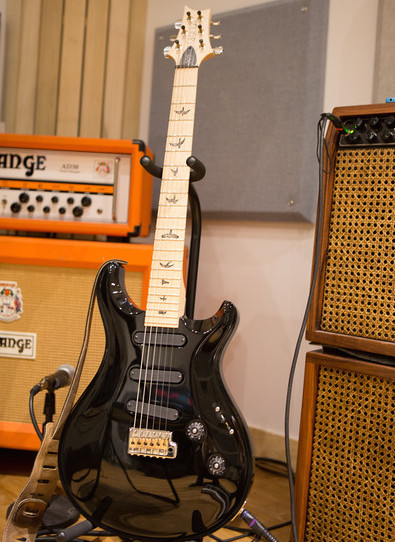 This is a guest post by Freddy Charles
This is a guest post by Freddy Charles
For nearly 18 years I played Fender Stratocasters exclusively. Obsessed with that signature bell-like Strat sound, I never really had any desire to change it up. A few years back though, while recording my third album, I was looking for a guitar with humbuckers that could deliver that chunky dirty rhythm sound. I assumed a Les Paul was the answer, but the guitar wasn’t a comfortable fit for me. Enter PRS! A friend loaned me a custom 24 to finish tracking, and I wound up being pleased with the results. It was my first encounter with the instrument and it left a mark. I went back to playing and recording with Strats until just recently.
The guitar I’m using now is a PRS 305, which is based on the 513 model, yet slightly modified. The body, unlike other PRS guitars is carved alder with a maple neck. It’s a single coil PRS with the same configuration as my trusty Fender, but with a completely unique sound. I’d been searching for a guitar that could deliver those clean Fender tones, and have the versatility to offer thick rich sounds as well. The PRS 305 knocked me off my feet! While the guitar is stocked with Paul’s signature single coil pickups, this is no Strat, and sounds like no other single coil guitar I’ve heard. The pickups have a bite to them, and are ultra responsive to the pressure of the pick. The tone is generally fatter than other singe coil guitars in all of the settings as well. PRS keeps things simple by utilizing just one tone knob, and I for one really enjoy the simplicity. Out of the box the guitar is set-up with low action and equipped with PRS 0.10 gauge strings.
To experience the tonal possibilities of the 305, lets begin with the neck pickup. When selected, you’ll be able to emulate some of those super clean signature coil sounds, but the attack and resonance are far superior. You’ll get a more rich sounding tone, with more mid-range than a Strat. The same goes when you split the neck and middle pickup- you get that fat Texas sound- perfect for any blues scenario, but with more pop and power. The low end, unlike other single coil guitars is tremendous, and confirms why this is such a fantastic instrument. You need not worry about those thin-sounding chords when the gain is cranked up either. The bottom end delivers humbucking power, quite impressive for this type of pickup configuration. As you continue to toggle the pick-up selector, flip it to the middle coils and crank up the overdrive. The guitar growls-giving way to any hard rock music you may be playing. In my opinion, the middle pickup functions and sounds more like a humbucker rather than a single coil. This setting is great for smooth leads or heavy riffing, and even when played clean has endless sustain and punchiness.
The final two settings, middle/bridge and bridge can also pull in those familiar single coil twangy sounds, but again different than what you would expect. The overall warmth of the guitar is astounding even as you use the settings closer to the bridge. These setting work well for funky chord phrases or chicken-picking licks.
As far as playability goes, it’s hard to beat a PRS. The 305 has a slightly thicker neck than the Custom 22’s and 24’s, but it’s an easy transition for a Fender or Gibson player. The maple fretboard is smooth and fast, you won’t have any issues running up and down the neck. The body is the traditional beautifully carved PRS shape allowing for high register playing and chording with incredible ease. It’ an extremely adaptable guitar as well- it doesn’t take more than a few minutes for you to get comfortable playing it for the first time.
If I had to sum it up in one word-versatile. The ability to channel all of those tonal nuances makes the 305 a rare find. I can’t think of any musical setting that the PRS 305 couldn’t handle.
GuitarToneTalk.com is a participant in the Amazon Services LLC Associates Program, an affiliate advertising program designed to provide a means for sites to earn advertising fees by advertising and linking to Amazon.com
